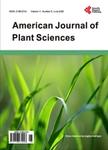Estimation of Peanut Maturity Using Color Image Analysis
Estimation of Peanut Maturity Using Color Image Analysis作者机构:Department of Biological Systems Engineering University of Nebraska-Lincoln Lincoln NE USA Panhandle Research and Extension Center University of Nebraska-Lincoln Scottsbluff NE USA Department of Plant Environmental Science Clemson University Clemson SC USA Edisto Research and Education Center Clemson University Blackville SC USA University of Georgia-Athens Cooperative Extension Athens GA USA
出 版 物:《American Journal of Plant Sciences》 (美国植物学期刊(英文))
年 卷 期:2024年第15卷第8期
页 面:617-635页
学科分类:08[工学] 0812[工学-计算机科学与技术(可授工学、理学学位)]
主 题:Peanut Maturity Mesocarp Exocarp Mahalanobis Distance Statistical Regression
摘 要:Peanuts pods grow underground and mature unevenly, resulting that choosing the correct time to harvest is more complicated than other crops. Pod maturity can be determined by blasting with a pressure washer to remove outer skin of the pod (exocarp) to expose the color of the middle layer (mesocarp). The mesocarp color changes with maturity from white to yellow, orange, brown and finally black. The sum of percentage from orange, brown, and black mesocarp (OBB) color and black color (BL) represents the kernels that are mature enough to harvest. The goal of this research is to identify methodologies to estimate OBB and BL of the pods using RGB images taken in the field and validate the proposed model using other pod images. The Mahalanobis distance classification method was used to process sets of images and calculate pod area (number of pixels) corresponding to two classes (mesocarp and background) with nine different color groups. The results showed a performance of 94% effectiveness for mesocarp using Mahalanobis distance classification. Statistical regression for OBB and BL was developed based on 315 images of peanut pods taken from the field. The R2 and root mean square error of predicted and actual OBB were 0.93 and 4.1%, respectively. The R2 and root mean square error of predicted and actual BL were 0.88 and 1.8%, respectively. The validation of OBB using other images provided reasonable estimation (R2 = 0.98 and RMSE = 2.73%). This study introduces a novel, cost-effective, and non-destructive method for estimating peanut maturity using RGB imagery and Mahalanobis distance classification in the field. This innovative approach addresses the limitations of traditional methods and offers a robust alternative for real-time maturity assessment.



